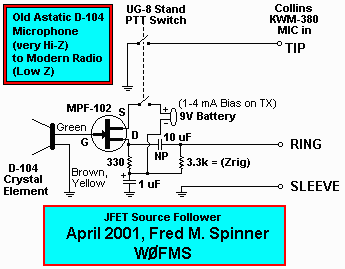
Here is the solution I came up with: a simple JFET Source Follower
circuit that I use with a "garage sale" (literally- my mother
bought it at a garage sale for me years ago) D-104 crystal element/"UG-8"
stand. This stand has a dual pole switch for PTT, so I use it to
"turn-off" the 9V battery bias in the microphone when PTT isn't depressed.
I'll eventually put in a switch in the stand somewhere so I can turn the
battery bias on (override?) for VOX and MOX operation, but that's a job
for another weekend, and when I see a suitable switch turn up at surplus.
The 9V battery should last a very long time in this setup as when active
the measure current is around 1.3 mA DC. This microphone currently
in use with my Rockwell Collins KWM-380, and sounds very good-- not "tinny"
like D-104's "supposedly" sound like with modern Lo-Z rigs. The circuit
is built on a Radio Shack Phenolic "Anyboard" cut to fit in the base, screwed
down in one of the terminal strip support screws. The 9V fits fairly
securly in the base when the bottom is screwed back on.

The JFET preamplifier provides a slight voltage loss, but a current/power gain for the microphone, resulting in a lower-Z output (selected by the "swamping" resistor marked Zrig above.) This provides a low-Z impedance to the rig, very Hi-Z to the D-104 crystal element, and everyone is happy. The device is very low noise at audio, and overall the microphone and circuit sound very good on the air.
This circuit can be adapted to other rigs as well. Newer rigs
like Kenwoods, Icoms and Yaesus often have 8-12V available on the mic plug.
If this is available, then that bias can be used instead of the 9V battery.